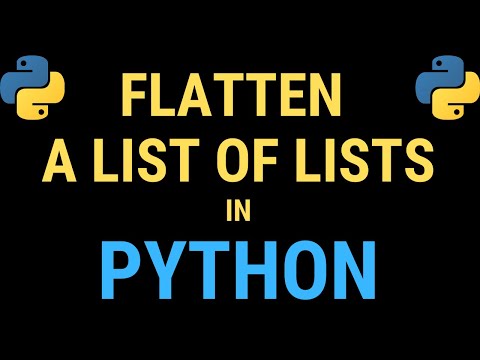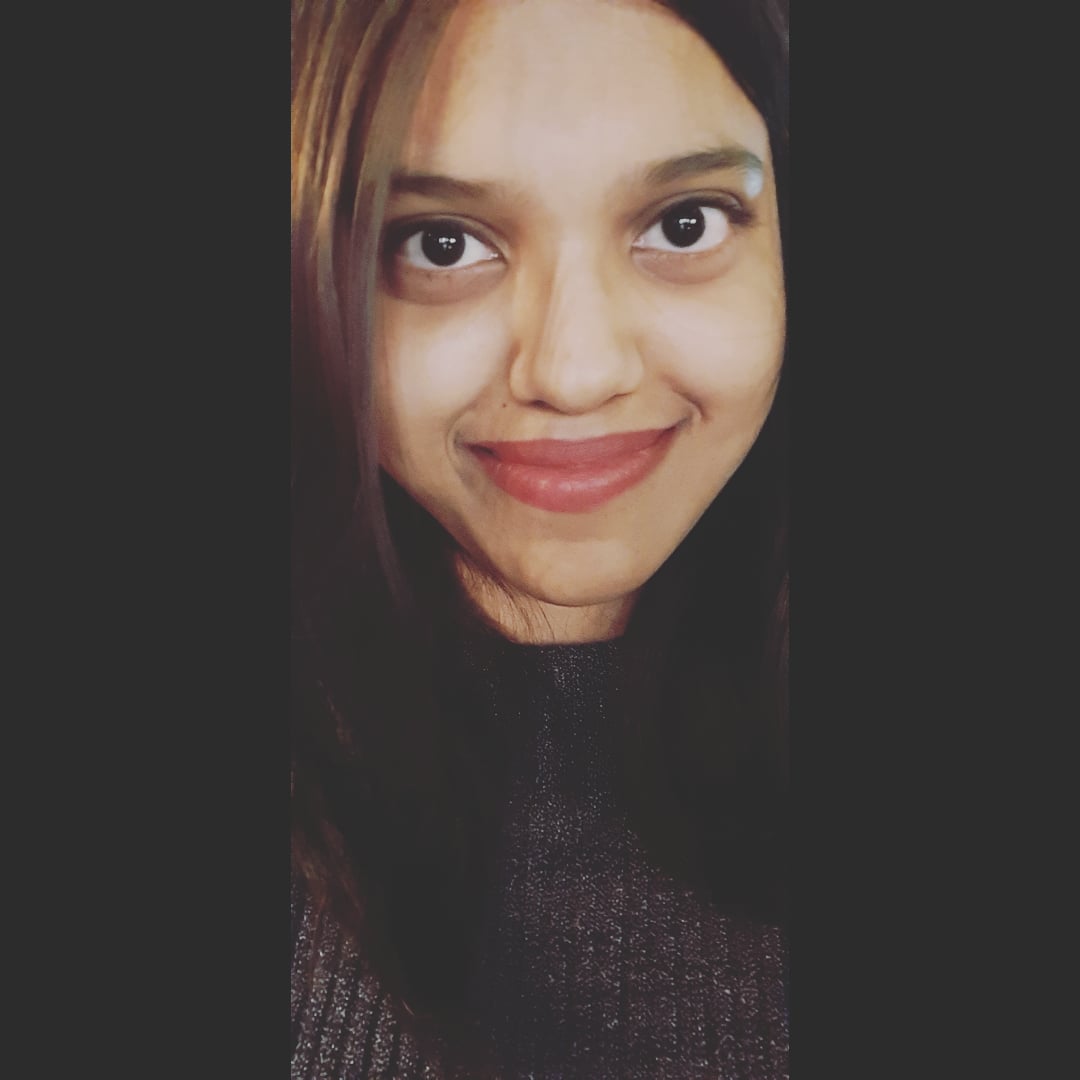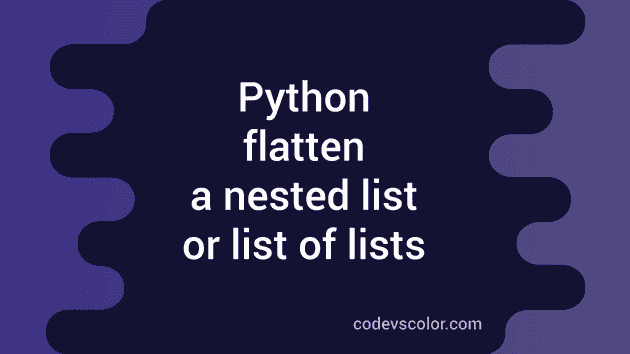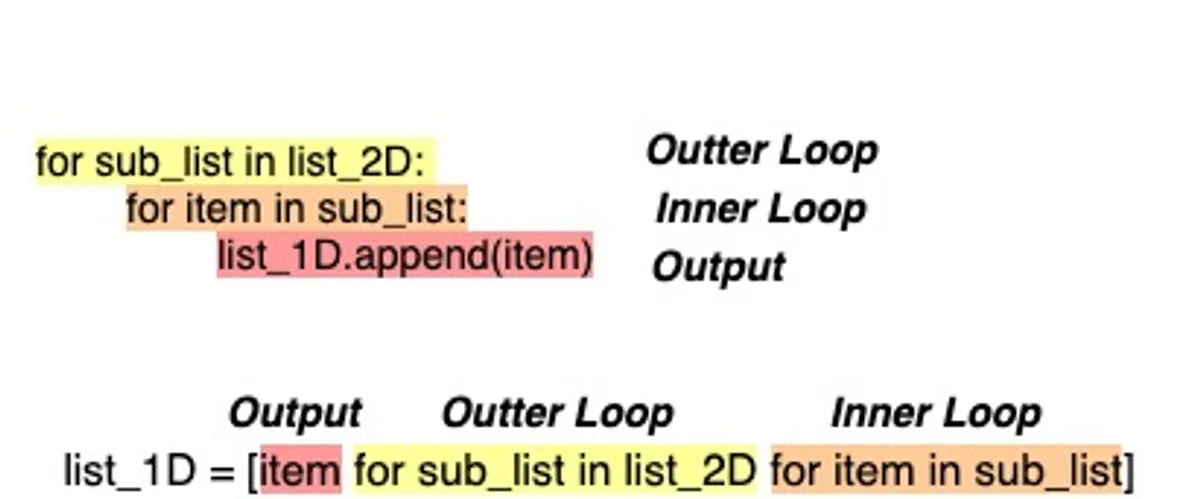Python Flatten List Of Lists
Overview:
Flattening a list of lists is a common task in Python programming. It involves converting a multi-dimensional list into a one-dimensional list. This article explores various methods and techniques to flatten a list of lists in Python. We will discuss the installation of the required tools, create a sample list of lists, and explore different approaches for flattening the list. Additionally, we will cover handling different types of elements and nested lists of varying depths.
Installation of the Required Tools:
Before we dive into flattening lists of lists, make sure you have Python installed on your system. You can download and install the latest version of Python from the official website. To check your Python version, open a terminal or command prompt and type ‘python –version.’ Additionally, we will be using the itertools and functools modules, which are part of the Python standard library, so no additional installation is required.
Creating a Sample List of Lists:
To better understand the process of flattening lists, let’s create a sample list of lists. Consider the following multi-dimensional list:
sample_list = [[1, 2, 3], [4, 5, 6], [7, 8, 9]]
This list consists of three sublists, each containing three elements. We will use this sample list to demonstrate the need for flattening and explore different methods for achieving it.
Using Nested For Loops:
One way to flatten a list of lists is by using nested for loops. We iterate over each sublist and append its elements to a new list. Here’s an example of how to implement this method:
flattened_list = []
for sublist in sample_list:
for element in sublist:
flattened_list.append(element)
This approach uses two for loops to traverse through the nested list structure. However, it can become cumbersome for deeper nested lists and has a time complexity of O(n^2), where n is the total number of elements.
Using List Comprehension:
List comprehension is a concise and efficient way to create lists in Python. It can also be used to flatten lists of lists. The following code demonstrates how to accomplish this:
flattened_list = [element for sublist in sample_list for element in sublist]
This one-liner achieves the desired result by iterating over each sublist and element in the sublist. List comprehension provides a more concise way of flattening lists compared to nested for loops. However, keep in mind that list comprehension may not be suitable for large lists due to memory constraints.
Using Recursion:
Recursion is another method for flattening a list of lists. Recursion is a programming technique where a function calls itself within its definition. Here’s a recursive implementation for flattening lists:
def flatten_list(lst):
flattened = []
for element in lst:
if isinstance(element, list):
flattened += flatten_list(element)
else:
flattened.append(element)
return flattened
This recursive function checks each element of the list. If the element is itself a list, the function calls itself to flatten that sublist. This process continues until all nested lists are flattened. Recursion can be elegant but may lead to stack overflow errors and has a time complexity depending on the depth of nested lists.
Using itertools.chain():
The itertools module provides a chain() function to flatten iterable objects. Here’s how you can use it to flatten a list of lists:
import itertools
flattened_list = list(itertools.chain(*sample_list))
The chain() function takes multiple iterables as arguments and concatenates them. In this case, we pass in the sample_list using the * operator to unpack it. The result is a flattened list. Using itertools.chain() is efficient and has good performance for flattening lists.
Using functools.reduce():
The functools module offers the reduce() function, which can be utilized to flatten a list of lists. Here’s an example of how to use it:
import functools
flattened_list = functools.reduce(lambda x, y: x + y, sample_list)
The reduce() function reduces a sequence of elements to a single value by repeatedly applying a function. In this case, we use the lambda function to concatenate the sublists together. However, this method requires the input to be a list of lists, and it may not be as efficient as other methods.
Using a Custom Flatten Function:
If none of the built-in methods suit your needs, you can create a custom function to flatten a list of lists. Here’s an example of how to implement one:
def custom_flatten(lst):
flattened = []
for element in lst:
if isinstance(element, list):
flattened.extend(custom_flatten(element))
else:
flattened.append(element)
return flattened
This custom_flatten() function works similarly to the recursive method discussed earlier. It checks each element of the list and recursively flattens any nested lists. You can modify this function to suit your specific requirements.
Handling Different Types of Elements:
While flattening lists, you may encounter non-iterable elements or elements of different types within nested lists. To handle these situations, you can add conditionals within your flattening methods. For non-iterable elements, you can simply append them directly to the flattened list. For elements of different types, you may need to convert them to sublists or handle them in a different way depending on your use case.
Handling Nested Lists of Different Depths:
Nested lists can have different depths, meaning some sublist may have more levels of nesting than others. To handle such scenarios, you can modify the existing methods to handle lists of different depths. You may need to add additional conditionals or recursion levels to ensure every element is properly flattened. Keep in mind the potential increase in time complexity and stack depth when dealing with deeply nested lists.
FAQs:
Q: Why do we need to flatten a list of lists?
A: Flattening a list of lists converts a multi-dimensional list structure into a one-dimensional list. This can be useful for various tasks such as data analysis, processing nested data structures, or simplifying the list for further operations.
Q: What is the advantage of using itertools.chain() or functools.reduce() over other methods?
A: itertools.chain() and functools.reduce() provide efficient and concise ways to flatten lists. They leverage built-in functions from the Python standard library and are suitable for most use cases. However, the choice of method depends on the specific requirements and constraints of your project.
Q: Can I use these methods for other iterable objects besides lists of lists?
A: Yes, these methods are not limited to lists of lists. They can be applied to other iterable objects, such as tuples, sets, or generators. Just ensure to adapt the code accordingly.
Q: Are there any limitations to be aware of when using recursion for flattening lists?
A: Recursion can lead to stack overflow errors when dealing with deeply nested lists. It is essential to keep track of the depth and complexity of your data structure to avoid these issues.
Q: Is there a maximum depth for nested lists that these methods can handle?
A: There is no predefined maximum depth for nested lists that these methods can handle. However, keep in mind that as the depth increases, time complexity and stack depth may also increase, impacting the performance and stability of your code.
In conclusion, flattening a list of lists in Python is a common task that can be accomplished through various methods. This article discussed different methods, including nested for loops, list comprehension, recursion, itertools.chain(), functools.reduce(), and custom functions. We also explored handling different types of elements and nested lists of varying depths. By understanding these techniques, you can choose the most appropriate method based on your specific requirements and constraints. Flatten list Python, Flatten list of arrays python, Convert list to list of lists Python, Unnest list Python, List of list into list python, unpack a list of lists python, python list comprehension flatten, flatten list of strings python, and python flatten list of lists.
Python – 6 Ways To Flatten A List Of Lists (Nested Lists) Tutorial
Keywords searched by users: python flatten list of lists Flatten list Python, Flatten list of arrays python, Convert list to list of lists Python, Unnest list Python, List of list into list python, unpack a list of lists python, python list comprehension flatten, flatten list of strings python
Categories: Top 95 Python Flatten List Of Lists
See more here: nhanvietluanvan.com
Flatten List Python
Introduction:
When working with complex data structures in Python, it is often necessary to flatten a nested list, i.e., convert it into a single-level list. This process, commonly referred to as “flattening,” can greatly simplify data manipulation tasks, allowing for easier handling and analysis. In this article, we will explore various methods to flatten a list in Python, discuss their pros and cons, and provide some helpful tips. So, let’s dive in!
Understanding Nested Lists:
Before we delve into flattening techniques, let’s first understand what a nested list is. In Python, a nested list is a list that contains other lists as its elements. This structure enables the creation of more complex data hierarchies, as each list can further contain lists within it. For example, consider the following nested list:
“`
nested_list = [[1, 2, 3], [4, 5, 6], [7, 8, 9]]
“`
Here, `nested_list` contains three sublists, with each sublist representing a row of numbers. To simplify this nested structure, we need to flatten it into a single-level list like this:
“`
flattened_list = [1, 2, 3, 4, 5, 6, 7, 8, 9]
“`
Now that we have a clear understanding of what a nested list is and what flattening means, let’s explore some methods to achieve this in Python.
Methods to Flatten a List:
1. Using List Comprehension:
List comprehension is a powerful Python construct that allows us to create new lists based on existing lists. To flatten a nested list using list comprehension, we can combine nested for loops and list concatenation, as shown below:
“`python
flattened_list = [item for sublist in nested_list for item in sublist]
“`
This syntax iterates over the sublists within the nested list and appends each item to the new list. The resulting list comprehension flattens the nested list effortlessly.
2. Using Recursion:
Another approach to flatten a list is through recursion, a technique where a function calls itself repeatedly until a condition is met. We can define a recursive function to flatten a nested list by checking the type of each element. If an element is itself a list, we recursively call the function to flatten it. Otherwise, we append the element to the resulting list. Here’s an implementation:
“`python
def flatten_list(nested):
flattened = []
for item in nested:
if isinstance(item, list):
flattened.extend(flatten_list(item))
else:
flattened.append(item)
return flattened
flattened_list = flatten_list(nested_list)
“`
This recursive approach effectively handles even deeply nested lists but requires careful consideration to avoid infinite loops.
3. Using itertools.chain():
The `itertools` module in Python provides a valuable tool called `chain()`, which can be used to flatten a list effectively. The `chain()` function takes multiple iterables as arguments and returns a single iterator that produces elements from each iterable in sequence. By passing the nested list as an argument to `chain()`, we can conveniently flatten it. Check out this implementation:
“`python
import itertools
flattened_list = list(itertools.chain(*nested_list))
“`
Note that we pass `nested_list` using the unpacking operator `*`, which expands the list into separate arguments for `chain()`. Lastly, we convert the resulting iterator to a list.
4. Using the itertools.chain.from_iterable():
Alternatively, we can achieve the same result using the `chain.from_iterable()` function from the `itertools` module. This function takes a single iterable as an argument and returns an iterator that produces all elements from the iterable. Here’s an example:
“`python
import itertools
flattened_list = list(itertools.chain.from_iterable(nested_list))
“`
This method eliminates the need for unpacking and provides a more concise way to flatten a nested list.
FAQs:
Q1. Can a nested list contain elements of different data types?
Yes, Python allows nesting elements of different data types within a list. For instance, a nested list can contain integers, strings, booleans, or even other complex objects like dictionaries or sets.
Q2. Does the order of elements change during the flattening process?
No, the order of elements remains the same while flattening a list. The purpose of the flattening process is solely to convert the nested structure into a single-level list, without altering the order in which the elements were originally arranged.
Q3. Are there any limitations in terms of the depth of nesting?
Python does not enforce any limit on the depth of nested structures. However, practical limitations arise due to system resources and computational complexity. Extremely deep nesting structures may lead to issues like excessive memory usage and recursive function call stack limits.
Q4. Can the same flattening technique be applied to lists of tuples or sets?
Yes, the techniques described in this article can be used to flatten lists of tuples or sets as well. As long as the nested structure consists of iterable objects, the mentioned methods can effectively handle the flattening process.
Conclusion:
Flattening a nested list is an essential technique in Python to simplify the manipulation of complex data structures. In this article, we explored several methods, including list comprehension, recursion, and itertools functions, to achieve this goal. Each technique offers distinct advantages and can be chosen based on the specific requirements of the task at hand. By mastering these techniques, you’ll gain the flexibility to handle nested data with ease and efficiency. Happy coding!
Flatten List Of Arrays Python
When working with Python, you may often come across situations where you need to flatten a list of arrays. Flattening refers to the process of converting a multidimensional array or a nested list into a single-dimensional array or list. In this article, we will explore various methods and techniques to accomplish this task in Python. So, let’s dive into the world of flattening lists of arrays!
Flattening using itertools.chain
Python’s itertools module provides a powerful function called chain, which can concatenate multiple iterables into a single iterable. By utilizing this function, we can easily flatten a list of arrays. Let’s look at an example:
“`python
import itertools
list_of_arrays = [[1, 2, 3], [4, 5, 6], [7, 8, 9]]
flattened_list = list(itertools.chain(*list_of_arrays))
print(flattened_list) # Output: [1, 2, 3, 4, 5, 6, 7, 8, 9]
“`
In the above code snippet, we import the itertools module and use the chain function to concatenate the arrays within the list_of_arrays. The * operator is used to unpack the list into separate positional arguments for chain. Finally, we convert the flattened iterator into a list.
Flattening using numpy.flatten
If you are working with NumPy arrays, you can take advantage of the flatten function provided by the library to flatten a list of arrays efficiently. Here’s how you can do it:
“`python
import numpy as np
list_of_arrays = [np.array([1, 2, 3]), np.array([4, 5, 6]), np.array([7, 8, 9])]
flattened_list = np.concatenate(list_of_arrays).flatten()
print(flattened_list) # Output: [1 2 3 4 5 6 7 8 9]
“`
In this example, we use NumPy’s concatenate function to join the arrays within the list_of_arrays along a given axis (axis=0 by default). Then, we apply the flatten method on the concatenated array to obtain the flattened list.
Flattening using recursion
Another approach to flatten a list of arrays is through a recursive function. This method works well with nested lists of arrays without the need for external libraries. Let’s take a look at the code:
“`python
def flatten_list(arr):
flattened_list = []
for i in arr:
if isinstance(i, list):
flattened_list += flatten_list(i)
else:
flattened_list.append(i)
return flattened_list
list_of_arrays = [[1, 2, 3], [4, [5, 6]], [7, 8, [9]]]
flattened_list = flatten_list(list_of_arrays)
print(flattened_list) # Output: [1, 2, 3, 4, 5, 6, 7, 8, 9]
“`
In the code above, we define a recursive function, flatten_list, that takes a list as input. The function iterates over each element of the input list. If an element is itself a list, the function recursively calls itself with that nested list. Otherwise, the element is appended to the flattened_list. Finally, the function returns the flattened list.
FAQs about flattening a list of arrays in Python:
Q1: Can I flatten multi-dimensional arrays as well using these methods?
A1: Absolutely! The mentioned techniques work for both nested lists of arrays and multidimensional arrays.
Q2: Are there any performance differences between the methods?
A2: Yes, there can be performance variations. The numpy.flatten method tends to be faster for large arrays due to its optimized implementation.
Q3: How can I preserve the original shape of the array while flattening?
A3: If you want to maintain the original shape of the array, you can use the numpy.ravel function instead of numpy.ndarray.flatten.
Q4: Is there any limit to the depth of nesting these methods can handle?
A4: The recursive approach can handle any depth of nesting as long as the system’s recursion limit allows it. However, excessive nesting may lead to a “RecursionError: maximum recursion depth exceeded” exception.
Q5: Can I use these methods with arrays of different data types?
A5: Yes, these methods work with arrays of different data types, including integers, floats, and even strings.
In conclusion, flattening a list of arrays in Python can be achieved through various methods, such as using itertools.chain, numpy.flatten, or a recursive function. Each method offers its own advantages, so choose the one that best suits your needs. Remember to consider performance considerations and the structure of your data while selecting the appropriate method. With these techniques at your disposal, you can easily handle and manipulate multidimensional arrays or nested lists efficiently in Python.
Convert List To List Of Lists Python
In Python, lists are one of the most commonly used data structures. They are a versatile way of storing and manipulating data. However, there may be scenarios where you need to convert a single list into a list of lists. This can be useful when you want to group elements from the original list based on certain criteria. In this article, we will explore different methods to convert a list into a list of lists in Python.
Method 1: Using List Comprehension
One of the simplest ways to convert a list to a list of lists is by using list comprehension. List comprehension allows us to create a new list by iterating over an existing list and applying some conditions or transformations to each element. In this case, we can use list comprehension to create a new list of lists where each sublist contains only one element from the original list.
Here is an example:
“`python
original_list = [1, 2, 3, 4, 5]
list_of_lists = [[x] for x in original_list]
print(list_of_lists)
“`
Output:
“`python
[[1], [2], [3], [4], [5]]
“`
Method 2: Using Nested Loops
Another approach to converting a list to a list of lists is by using nested loops. In this method, we iterate over the original list and create a new sublist for each element. By appending the sublist to a new list, we can achieve the desired result.
Here is an example using nested loops:
“`python
original_list = [1, 2, 3, 4, 5]
list_of_lists = []
for x in original_list:
sublist = [x]
list_of_lists.append(sublist)
print(list_of_lists)
“`
Output:
“`python
[[1], [2], [3], [4], [5]]
“`
Method 3: Using the map() Function
The `map()` function in Python allows us to apply a specific operation to each element of a given list. By using this function along with the `lambda` keyword, we can convert a list to a list of lists.
Here is an example using the `map()` function:
“`python
original_list = [1, 2, 3, 4, 5]
list_of_lists = list(map(lambda x: [x], original_list))
print(list_of_lists)
“`
Output:
“`python
[[1], [2], [3], [4], [5]]
“`
Method 4: Using the zip() Function
The `zip()` function in Python allows us to combine multiple lists into a single list of tuples. By extending this concept, we can create a list of lists by only having one element in each sublist.
Here is an example using the `zip()` function:
“`python
original_list = [1, 2, 3, 4, 5]
list_of_lists = [[x] for x in zip(original_list)]
print(list_of_lists)
“`
Output:
“`python
[(1,), (2,), (3,), (4,), (5,)]
“`
In this example, each element of the original list is first converted to a tuple using `zip()`, and then a list is created by enclosing each tuple in square brackets.
Frequently Asked Questions
Q: Can I convert a list containing multiple data types into a list of lists?
A: Yes, you can convert a list containing any data type, including mixed data types, into a list of lists using the methods described above.
Q: How can I convert a list to a list of lists based on a specific condition?
A: If you want to group elements of the original list into sublists based on a specific condition, you can modify the transformation part of the list comprehension, lambda function, or nested loop based on your condition.
Q: Can I convert a list of strings into a list of lists in Python?
A: Absolutely! The approaches explained in this article work for any type of data, including strings. Simply replace the numeric values in the examples with the desired strings.
Q: Is it possible to convert a list of lists back into a single list?
A: Yes, you can easily convert a list of lists back into a single list using various methods like list comprehension or nested loops.
In conclusion, converting a list to a list of lists in Python can be achieved through different methods such as list comprehension, nested loops, the map() function, or the zip() function. Each method allows you to achieve the same result, but the choice of method depends on your preference and the complexity of the scenario at hand. By understanding and implementing these methods, you can efficiently transform and manipulate your data in Python.
Images related to the topic python flatten list of lists

Found 14 images related to python flatten list of lists theme











































Article link: python flatten list of lists.
Learn more about the topic python flatten list of lists.
- How do I make a flat list out of a list of lists? – Stack Overflow
- Python: How to Flatten a List of Lists – Stack Abuse
- How to Flatten a List of Lists in Python
- Flatten List of Lists in Python: Top 5 Methods (with code)
- How to flatten a list of lists in Python – nkmk note
- Python Program to Flatten a Nested List – Programiz
- How to flatten a list of lists in Python
- How to flatten list in Python? – TutorialsTeacher
- List Flatten in Python – Flattening Nested Lists – freeCodeCamp
- Python Flatten List: A How-To Guide – Career Karma
See more: nhanvietluanvan.com/luat-hoc